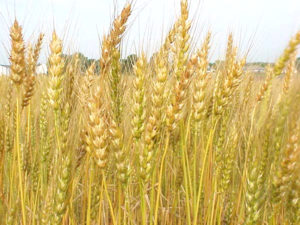 Wheat dropped on Wednesday amid expectations for increased output in Australia, the world s fourth-biggest exporter. Favorable weather conditions are projected to boost production as rains moistened soils.
Wheat dropped on Wednesday amid expectations for increased output in Australia, the world s fourth-biggest exporter. Favorable weather conditions are projected to boost production as rains moistened soils.
On the Chicago Mercantile Exchange, wheat futures for July delivery fell 0.55% on the day and stood at $6.9238 a bushel at 8:54 GMT. Prices varied between days low of $6.9113 and high at $6.9463.
According to the Australian Bureau of Agricultural and Resource Economics and Sciences, wheat production is set to reach 25.4 million metric tons for the 2013-2014 crop year, up from Marchs 24.9 million estimate and well above last years 22.1 million tons.
Michael Pitts, a commodity sales director at National Australia Bank Ltd., said by phone for Bloomberg: “North of 25 million is a relatively high number. We’re also forecasting what should be pretty good rains across New South Wales in particular over the next few days so it’s a positive estimate and definitely it’s a slightly bearish market.”
Wheat prices kept being pressured as favorable crop conditions in the Black Sea region suggested an increased supply from Russia and Ukraine. Also, according to forecaster DTN, drier and hotter conditions later this week and early next week will assist harvesting in the U.S.
According to USDA’s report on Monday, as of the week ending June 9 87% of the nation’s spring wheat was planted, compared to 80% in the preceding week. This is below the same time last year’s full completion and the five-year average 96% figure. The USDA said 43% of the winter wheat crop was of “Very poor” and “Poor” quality and 25% fell in the “Fair” category. Only 32% was categorized as “Good” and “Excellent”. Last year 17% of the crop was assessed as “Very poor” and “Poor”, 30% as “Fair” and 53% was rated “Good” and “Excellent”.
Elsewhere on the grains market, soybeans fell 0.27% on the day and traded at $15.4538 a bushel at 9:08 GMT. Prices ranged between days low of $15.3863 and high at $15.4575.
The USDA reported on Monday that 71% of the U.S. soybeans crop was planted as of June 9, compared to 57% in the preceding week. This is well below last year’s 97% during the same week and the five-year average of 84%. According to USDA’s report, 48% of the crop has emerged, 17% above the preceding week’s figure. This is also lower than last year’s 88% and the five-year average 67$ figure.
Meanwhile corn futures for July delivery gained 0.17% for the day to trade at $6.6050 a bushel at 9:14 GMT, marking a new days high, while days low was at $6.5713. Corn prices dipped 2.2% on Monday, the most in five weeks, amid speculation that favorable weather will assist crop developing.
In its weekly crop progress report, the U.S. Department of Agriculture said yesterday that 95% of the nation’s corn crop was planted as of the week ending June 9, compared to 91% in the preceding week. This is lower than the same time last year when 100% of the crop was planted and is also below the five-year average of 98%. According to USDA’s report, 7% of the corn crop fell in the “Very poor” and “Poor” condition categories and 30% was assessed as “Fair”, which shows improvement compared to last year when 8% was “Very poor” and “Poor” and 26% “Fair”. As of last week 63% of the corn crop was of “Good” and “Excellent” quality, slightly lower than last year’s 66%.





